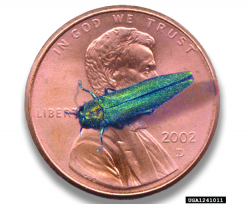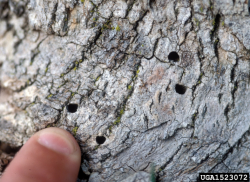February 2, 2018
February 2, 2018New Mexicans are the First Line of Defense in Preparing for Emerald Ash Borer Attack
Question:
I’m concerned about the threat of the emerald ash borer in New Mexico. Should residents and cities be planting ash trees?
- Concerned Citizen of Otero County via County Agriculture Agent, Sid Gordon
Answer:
The first step in dealing with what looks to be an imminent invasion of emerald ash borer (EAB) in New Mexico is educating ourselves on how this pest works, what to look for, and how to report anything suspicious
Since 2002, when EAB was first identified in Michigan, it has killed or harmed hundreds of millions of ash trees in 31 states, including Colorado, Texas, Louisiana, and Oklahoma. Many experts believe New Mexico could be next on the list. Scarier still, it could already be here and just not have been identified yet.
The EAB is a pretty, narrow-bodied, metallic green, wood-boring beetle (Fig. 1) that may cause minor foliar damage while in its adult stage, but the larvae feed on the inner bark (vascular system) of ash trees and are so aggressive that even healthy ash trees can die within two years. Another scenario is that the EAB larvae kill an ash tree slowly, taking up to four years before symptoms are even visible. That information is from the Colorado State Forest Service, and they should know since the EAB was confirmed in Boulder, CO, in 2013.

What can and should we do about EAB risks in New Mexico? I checked with city parks experts from Santa Fe, Albuquerque, and Las Cruces about their EAB concerns. I also interviewed NMSU Extension Agents from Bernalillo and Doña Ana Counties, six nursery owners and managers from all over the state, and several NM Department of Agriculture and NM State Forestry experts for recommendations. Here's what they all agreed on:
-
Now is a good time to decrease new ash plantings and consider removing ash trees that are not performing well because those are likely more attractive to EAB than healthy trees. Provide existing ash trees with adequate irrigation. Examine ash trunks and major limbs for possible evidence of EAB infestation.
-
Ash trees have become too popular in our municipal and residential landscapes in New Mexico (and across the country), increasing the vulnerability to EAB attack. In order to diversify our tree populations, select native or adapted species that do well in your area.
-
Do not move firewood to or from another state -- always buy local and burn it where you buy it. This rule is not just true because of EAB threats; other borers and pests can be hitchhikers too.
NMSU Extension Entomologist and NMDA State Entomologist, Dr. Carol Sutherland, offers encouraging advice that can make an EAB scout out of all of us. "Keep looking," she says, "and take samples and photos of anything different or unusual occurring on your ash trees. When EAB arrives, it will most likely be YOUR problem in YOUR ash trees, not someone else's. What EAB confirmation takes is for an interested, involved citizen somewhere in New Mexico to pay close attention to his or her ash trees, starting again this spring when trees should produce a full canopy of leaves. Photograph D-shaped emergence holes (Fig 2) in ash tree bark, any increasing die-back in the canopy, and any peeling bark. Photograph loose bark from above and especially on the underside if you see any broad, flattened, winding tunnels. Promptly submit these photos plus your contact information to one of our many professionals who are trained and ready to help with the next steps. Chances are, we'll contact you for a field visit to collect more specimens for verification."
These trained professionals can be found at NMSU County Extension Offices (find your county's Extension Office at http://aces.nmsu.edu/county/), the NMSU Plant Diagnostic Clinic (http://aces.nmsu.edu/ces/plantclinic/), any of the six NM State Forestry District Offices, or other NM State Forestry Programs, including the Forest Health Program Office in Santa Fe. We are all taking the EAB threat seriously. Remember, it is important to get a positive EAB identification before cutting down trees.
Dr. Sutherland adds, "Don't expect to see actual EAB beetles first and damage second. These beetles and evidence of their initial attacks are easily overlooked."
Find info on how to identify an ash tree, lists of recommended trees for improved species diversification, and links to more EAB resources at Desert Blooms.

Marisa Y. Thompson, PhD, is the Extension Horticulture Specialist, in the Department of Extension Plant Sciences at the New Mexico State University Los Lunas Agricultural Science Center, email: desertblooms@nmsu.edu, office: 505-865-7340, ext. 113.
Links:
For more gardening information, visit the NMSU Extension Horticulture page at Desert Blooms and the NMSU Horticulture Publications page.
Send gardening questions to Southwest Yard and Garden - Attn: Dr. Marisa Thompson at desertblooms@nmsu.edu, or at the Desert Blooms Facebook page.
Please copy your County Extension Agent and indicate your county of residence when you submit your question!